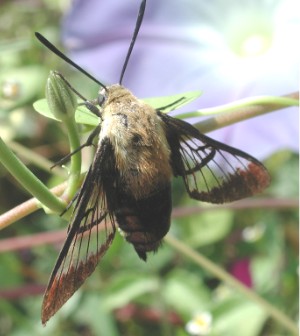
Hemaris is a genus of sphinx moths in the subfamily Macroglossinae, which is native to the Holarctic. Their main host plants are herbs and shrubs of the teasel and honeysuckle families. Moths in genus Hemaris are known collectively as clearwing moths or hummingbird moths in the US and Canada and bee hawk-moths in Britain. The related Old World hummingbird hawk-moths, genus Macroglossum, are similar in appearance and habits. Both genera have tails that are provided with an expansile truncated tuft of hairs, but only Hemaris has the disc of the wings transparent, as these scales are dropped soon after eclosion.

Theretra silhetensis, the brown-banded hunter hawkmoth, is a moth of the family Sphingidae described by Francis Walker in 1856. It lives in Indo-Australia, India, Sri Lanka, Papua New Guinea, East Australia, Solomon Islands, Fiji Islands, Vanuatu Islands.

Hemaris tityus, the narrow-bordered bee hawk-moth, is a moth of the family Sphingidae which is native to the Palearctic.
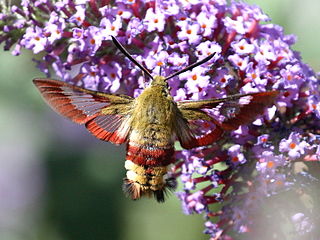
Hemaris fuciformis, known as the broad-bordered bee hawk-moth, is a moth of the family Sphingidae.

Hemaris croatica is a moth of the family Sphingidae. It was described by Eugenius Johann Christoph Esper in 1800.

Marumba cristata, the common striped hawkmoth, is a species of moth of the family Sphingidae. It is found from the Himalaya, through Nepal and north-east India, southern and central China to western Malaysia (Sundaland).

Angonyx testacea, the northern dark-green hawkmoth, is a moth of the family Sphingidae.
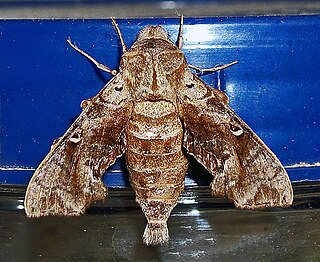
Neogurelca hyas, the even-banded hawkmoth, is a moth of the family Sphingidae first described by Francis Walker in 1856.

Cechenena lineosa, the striped green hawkmoth, is a moth of the family Sphingidae. It is known from northern India, Nepal, Bangladesh, Myanmar, Thailand, southern China, Taiwan, Vietnam, Malaysia and Indonesia.
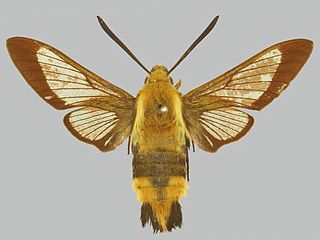
Hemaris affinis, the honeysuckle bee hawkmoth, is a moth of the family Sphingidae. It is known from Mongolia, the Russian Far East, northern, central and eastern China, Taiwan, North Korea, South Korea and Japan.

Hemaris ducalis, the Pamir bee hawkmoth, is a moth of the family Sphingidae. It is known from the mountains of south-western Xinjiang in China, the western Tian Shan, southern and eastern Kazakhstan up to the Altai Mountains, western Mongolia, southern Uzbekistan, Kyrgyzstan, Tajikistan, northern Afghanistan and Pakistan.
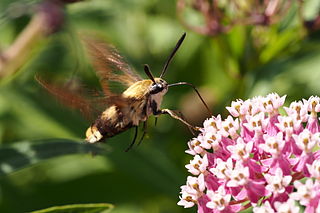
Hemaris radians is a moth of the family Sphingidae. It is known from southern Siberia, Mongolia, the southern Russian Far East, north-eastern and central-eastern China, the Korean Peninsula and Japan.

Hemaris alaiana, the Alai bee hawkmoth, is a moth of the family Sphingidae. The species was first described by Walter Rothschild and Karl Jordan in 1903. It is known from the Alayskiy Khrebet, Tian Shan, Dzungarian Alatau, Saur and Altai mountains, from Tajikistan and eastern Kazakhstan to western Mongolia. The habitat consists of montane meadows and woodland glades rich in flowers, generally from 1,400 to 2,200 meters altitude.
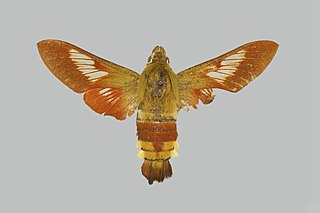
Hemaris dentata, the Anatolian bee hawkmoth, is a moth of the family Sphingidae. The species was first described by Otto Staudinger in 1887. It is known from southern Turkey as far west as the Taurus Mountains.
Hemaris syra, the broad-bordered bee hawkmoth, is a moth of the family Sphingidae. The species was first described by Franz Daniel in 1939. It is known from southern and eastern Turkey, the western Zagros Mountains and northern Alborz Mountains of Iran, the Kopet Dag mountains of Turkmenistan, western Jordan, and northern Israel. The habitat consists of open remnants of former woodland, especially where Lonicera grows through and over low shrubs. It occurs at around 1,000 meters altitude in southern Turkey and from 1500 to 1600 meters in northern Israel.

Hemaris rubra, the Kashmir bee hawkmoth, is a moth of the family Sphingidae. The species was first described by George Hampson in 1893. It is known from a number of valleys in Kashmir. The habitat consists of flower-rich meadows at around 2,500 meters.
Hemaris galunae is a moth of the family Sphingidae. The species was first described by Ulf Eitschberger, Günter C. Müller and Vasiliy D. Kravchenko in 2005. It is known from Syria.
Hemaris molli is a moth of the family Sphingidae. The species was first described by Ulf Eitschberger, Günter C. Müller and Vasiliy D. Kravchenko in 2005. It is known from Jordan.

Dolbina inexacta, the common grizzled hawkmoth, is a species of moth of the family Sphingidae.
















